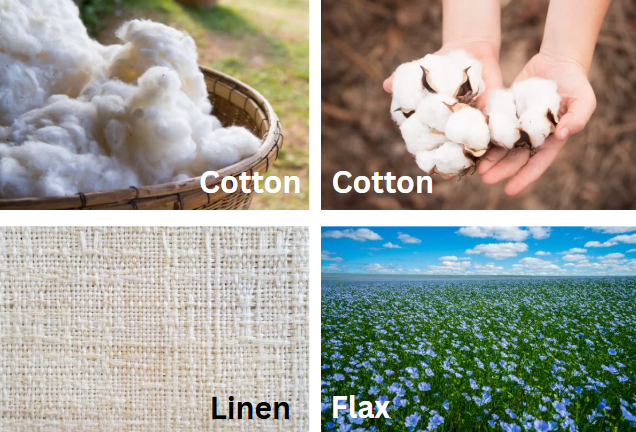Why Choosing Natural Fabrics Can Change the Way You Feel
I decided to write a blog on this great topic, since not long ago, my son made a small but powerful switch: he decided to wear only natural fabrics. Cotton, linen, wool - you name it. At first, I thought it might be one of those short-lived experiments. But weeks later, he’s still raving about how much better he feels. He keeps commenting on it all the time how much more comfortable he feels and how he would never wear any other clothes again. Besides, they look really trendy I think.
Aaron Jumper and Linen Trousers
It got me thinking — are natural fabrics really that much better than the synthetic clothes most of us wear daily? The short answer: yes. So, let’s explore why.
What Are Natural Fabrics?
Natural fabrics come directly from plants or animals like:
Cotton from the cotton plant
Linen from flax
Wool from sheep
Silk from silkworms
Hemp and bamboo fibres
These have been worn for centuries. They’re breathable, biodegradable, and often kinder to the skin.
By contrast, synthetic fabrics like polyester, nylon, acrylic, and spandex are made from petroleum-based plastics. They’re newer, cheaper, and everywhere - from fast fashion T-shirts to gym leggings.
Benefits of Natural Fabrics
Breathability
Natural fabrics let air circulate. On hot days, cotton and linen keep you cool. In winter, wool insulates while still letting the skin breathe. This balance is something synthetics struggle to match.
Comfort for Sensitive Skin
Synthetic fibres often cause itching or rashes. Cotton and silk, by contrast, are soft and gentle. Many people with eczema or sensitive skin notice improvement when they move to natural clothing.
Less Sweat and Smell
Polyester may take moisture away, but it traps odour. Cotton and linen absorb sweat naturally and wash clean without clinging to smells. Wow, I never knew this one.
Biodegradability
When natural clothes eventually wear out, they return to the earth. Synthetics, on the other hand, shed microplastics every time you wash them — tiny bits that end up in rivers, oceans, and eventually in the food chain.
Durability with Care
Yes, natural fabrics can wrinkle or shrink if not treated properly. But linen becomes softer with every wash, and a good wool jumper can last for decades.
Downsides to Keep in Mind
It’s only fair to mention the challenges:
Wrinkling: Linen crumples quickly. But some say it’s part of its charm.
Price: Natural fibres can be more expensive, though they often outlast cheaper synthetics.
Care: Wool and silk may need handwashing or gentle cycles.
Even so, the benefits usually outweigh the fuss. My son certainly thinks so.
The Environmental Story
The fashion industry is one of the world’s biggest polluters. Fast fashion often relies on cheap polyester, which comes from fossil fuels. Every wash of a synthetic garment releases microfibres that wastewater plants can’t fully filter. These plastics end up in oceans and even in our drinking water.
By choosing natural fabrics, we reduce that plastic trail. It may not feel like a huge personal action, but multiplied across households, it adds up.
Practical Tips for Switching
If you’re curious to try what my son did, here’s how to start:
Check your labels Next time you shop, look for 100% cotton, linen, hemp, wool, or silk. Blends (like 60% cotton, 40% polyester) won’t give you the full benefit.
Start with basics Swap out T-shirts, underwear, and socks first. These are the clothes that touch your skin most.
Think second-hand Natural fabrics are widely available in charity shops and vintage stores. This keeps costs low and reduces waste.
Invest in quality One well-made cotton shirt can outlast several fast fashion tops.
Care properly Wash in cold water, line dry when possible, and store wool with lavender or cedar to deter moths.
How It Feels to Live in Natural Clothes
Tom describes it as a kind of relief. No more peeling off clammy T-shirts at the end of the day. No more irritation. He says he feels more “himself” in natural clothing. Amazing really, isn’t it.
It’s not just physical comfort - there’s a psychological element, too. Wearing something that comes from nature seems to connect us back to the earth in a subtle way. It feels grounding.
The Bigger Picture
Imagine if more people made the switch. Fewer microplastics, less reliance on oil, and healthier skin for millions. It may not solve all fashion’s problems, but it’s a practical step in the right direction.
And perhaps most importantly: it feels good. And when something feels good, you’re more likely to stick with it.
🌿PracticalGitti Thoughts
Watching Toms enthusiasm has been inspiring. His decision to wear only natural fabrics reminded me that small, everyday choices can have a big impact - not just on our health, but on the world around us.
If you’ve never tried it, maybe swap one synthetic item for a natural one and see how you feel. You might notice, like he did, that it changes more than just your wardrobe. From now on, every time I’ll buy something new, I’ll get a natural fabric.
Please let me know if you have switched to natural fabric or already wearing them and how it makes you feel. Thank you so much



